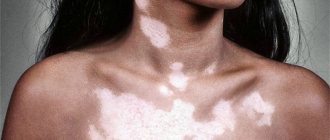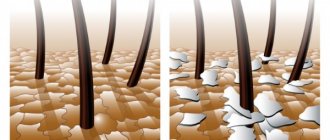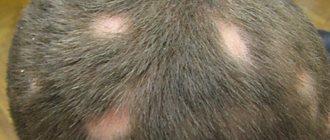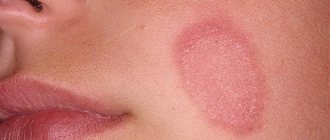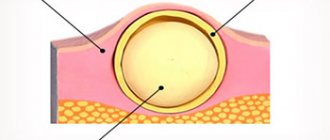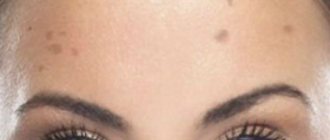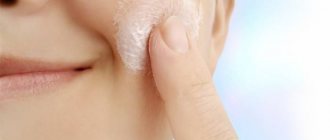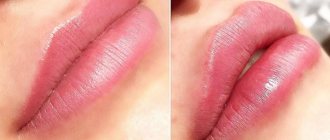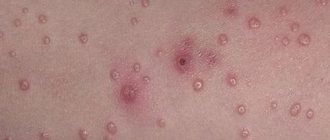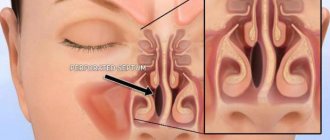Every person has encountered the problem of dandruff at least once in their life. Sometimes it appears seasonally and goes away quickly, and sometimes it torments for a long time. Most often, dandruff is a manifestation of a mild form of seborrheic dermatitis. The most common type of seborrhea is dry type. It manifests itself on the scalp (dandruff) and on the skin of the face (dryness and flaking). Dry seborrheic dermatitis can be cured using pharmaceutical shampoos, medications and traditional medicine.
"Dermazol", pharmaceutical shampoo for dry seborrhea
Peculiarities
Sebaceous ducts are present in any person. Their amount directly depends on age: in children and the elderly, sebum is secreted in small quantities, while the sebaceous glands of adults are fully activated.
In adolescents, the situation is different - during adolescence, too much sebum is released onto the surface of the skin, making the skin and hair shiny and unattractive.
Sebum, or sebum, in moderate quantities is essential for the human body. The secretion released protects the epidermis from drying out and penetration of microorganisms. There are different types of seborrhea, they differ from each other in the amount of sebum produced.
Types of seborrhea:
- Oily seborrheic eczema. The oily form of the disease is characterized by increased sebum production. Vivid signs of thick seborrhea are oily hair, wet dandruff and a face shiny with grease.
- Dry seborrhea. Many people mistake dry seborrheic dermatitis for normal dandruff. Small scales appear in the hair, the scalp constantly itches, and the hair becomes lifeless.
- The mixed form of seborrhea occurs less frequently than other types of the disease. With mixed seborrhea, the hair may be oily with thick dandruff, and the epidermis of the face may be dry and cracked.
Causes and symptoms
Dry seborrhea can occur under the influence of internal and external factors.
External causes of dry seborrhea:
- Frequent hair washing;
- Wearing tight hats;
- Hot air drying;
- Wrong shampoo;
- Incomplete rinsing of hair after washing;
- Frequent dyeing and perm.
Internal factors:
- Weak immunity;
- Malfunction of the digestive system;
- Constant stress;
- Overweight;
- Fungal infection;
- Hormonal dysfunction;
- Immunodeficiency.
Symptoms of dry scalp dermatitis bring a lot of inconvenience to a person.
Signs of the disease:
- Dry epithelium covered with small cracks;
- The scalp is covered with dry white flakes;
- Curls become lifeless and brittle;
- The appearance of seboreids - affected areas of the skin with a pink tint;
- Severe scalp irritation.
At an advanced stage of the disease, sores and bloody crusts appear at the site of small cracks. Incorrect treatment or its complete absence can lead to serious consequences.
Diet for seborrhea of the scalp
Dry seborrheic dermatitis on the head
Any experienced dermatologist with experience will say that dry seborrheic dermatitis is treated primarily with diet. The patient will have to give up a number of foods to stop the growth of the pathogenic fungus.
What you can eat:
- Freshly squeezed vegetable juices, fruit drinks, spring water.
- You can only eat dietary meat (poultry and rabbit). It is better to avoid beef, pork, lard, and turkey. Sea fish would be an excellent substitute.
- As for vegetables, it is advisable to add pumpkin, zucchini, seaweed, salads, spinach, and asparagus to your diet. It is better to avoid other vegetables.
- Dairy products include cottage cheese and kefir. You can eat porridge, but the milk should be diluted one to one.
- Berries are especially useful for dry seborrhea, especially cranberries, cherries, watermelon, blueberries, and gooseberries.
What not to eat while dieting:
- Any fatty and fried foods;
- No smoked meats (sausage) or pickled foods (mushrooms, cucumbers);
- We need to forget about fast food;
- Eliminate citrus fruits;
- No mushrooms, strawberries, fresh milk.
You should also give up smoking, alcohol, and sweets. Walk in the fresh air more often, normalize your sleep, don’t be nervous, and visit your doctor periodically.
Tatyana Aleksandrovna Pukhova
Dermatologist , 14 years of experience.
Generalist specialist. Engaged in the diagnosis and treatment of diseases of the skin, nails, scalp, as well as sexually transmitted diseases.
Education: 2006 Diploma in General Medicine, Perm State Medical University
Advanced training courses: 2011 “Pillings of superficial-medium impact” 2013 “Plasmolifting in cosmetology and trichology” 2014 “Dermatovenereology”, South Ural State Medical University
Diagnosis and treatment
Only a specialist can make a correct diagnosis and choose a course of treatment based on an examination of the patient.
Diagnostic methods:
- History of illness;
- Laboratory examination of blood composition;
- Diagnostics of the thyroid gland;
- Blood test for hormone levels.
Dry seborrhea of the scalp belongs to the category of diseases that, in the absence of medical care, become a chronic disease. The main goal of complex therapy is to identify the main cause of dry seborrhea and eliminate its symptoms.
Therapeutic treatment
After the diagnosis of dry seborrhea of the scalp is made, the patient is prescribed comprehensive treatment.
Types of therapeutic treatment:
- Elimination of chronic diseases of the digestive system.
- Strengthening the body's defenses.
- Physiotherapy: a relaxing scalp massage, a short stay under an ultraviolet lamp will speed up the healing process.
- A visit to a psychotherapist is necessary for frequent stress and depression.
Drug therapy
Medical methods of combating dry seborrhea of the scalp involve the use of various medications available in pharmacies.
Medical treatment options:
- If diagnostic results reveal a large amount of yeast fungus on the skin, the patient is prescribed antifungal drugs (Fluconazole and others).
- Anti-inflammatory agents are necessary for treating inflamed areas of the skin (Zinc and Salicylic ointments). (list of ointments for seborrhea)
- Antiseptics are needed when bleeding cracks appear.
- Antibiotics in the form of ointments are used if a bacterial infection is added to dry seborrhea of the scalp.
- Hormonal drugs can quickly relieve the symptoms of dry seborrhea, but do not eliminate the cause of the disease. Due to the large list of side effects, hormonal ointments are prescribed for advanced forms of seborrheic dermatitis of the facial skin.
- Shampoos. Without medicated shampoos, it is difficult to get rid of dandruff caused by dry seborrhea. Now pharmacies offer a huge selection of cosmetics for the care of curls containing zinc, tar and ketoconazole: Nizoral, Sebozol, Sulsena and other drugs. The remedy should be used at least twice every 7 days for a long time.
Causes
All cells of a living organism have the ability to renew themselves. For some of them this process takes a little time, but for others it takes the opposite. The cells of the scalp also have this property, and the time it takes to carry it out is about one month. This process is almost invisible, and therefore a person does not even know about it. If the cells are influenced by some third-party factors, then their renewal is accelerated, as a result of which a person notices the appearance of white scales on the head, which we call dandruff.
Following this, ulcers form, after which the person discovers active hair loss. This phenomenon indicates that the fungus is multiplying, and its result is clogging of the sebaceous glands. Activation of the process begins under the influence of the following fundamental factors:
- Stress, overexertion and mental fatigue.
- Problems of the functioning of the endocrine system. Hormones are directly involved in the process of regulating the functioning of human organs. Failure leads to various types of diseases. Seborrhea of the head can occur as a result of a disruption in the normal production of sebum, provoked by hormonal imbalance.
- Tendency towards genetic relatedness. If you review the history of your loved ones, this type of disease can be found in some of them.
- Vitamin deficiency or excess consumption of vitamins can also cause the development of dry seborrhea of the scalp.
- Poor nutrition. If a person’s diet is based on fatty, floury and salty foods, then they cannot avoid problems with seborrhea.
- If the body’s protective function decreases, then the fungus that is constantly present on the human skin begins to actively progress, causing its pathogenic activity.
The presence of at least one of the above factors leads to the development of this disease. If seborrhea of the scalp enters the complication stage, then the development of alopecia is possible. The disease will not disappear on its own, and if it is not eliminated, you can lose your hair forever.
Traditional methods of treatment
Folk recipes are most often used in the form of moisturizing masks and medicinal decoctions aimed at eliminating dandruff and nourishing the scalp. Using oils you can moisturize the epidermis and restore the hair follicle.
Principles of home treatment:
- Rubbing movements should be light and smooth. Excessive actions can cause hair damage.
- A large amount of oil clogs pores and disrupts sweating.
Types of folk remedies:
- Medicinal decoction of onion peels. Pour the raw material with water and boil for 10 minutes. Then the broth should sit for at least half an hour. Apply the strained liquid to the scalp and hair at least three times a week.
- Castor oil mask. A tablespoon of oil should be mixed with five large spoons of calendula alcohol tincture. It is advisable to rub the solution into the scalp every day until the dandruff stops.
- Nourishing mask for dry hair. One yolk is mixed with onion juice, honey and castor oil in equal proportions. The resulting mixture is thoroughly mixed and applied to dry hair. The procedure is carried out twice a week for two months.
- A remedy for hair and scalp made from honey and calendula. First, a decoction is prepared: dry calendula flowers are poured with boiling water and infused for about an hour. Then melted honey is added to the solution until a thick consistency is formed. The mask is applied to clean hair three times a week.
Treatment with folk remedies brings a positive effect in the complex treatment of the disease, using medications and therapeutic procedures.
How to treat dry seborrhea?
How to treat dry seborrhea?
This condition can be treated with medications, as well as with the help of proven traditional medicine recipes. But treatment should always begin with an examination by a specialist, since only he can accurately determine the degree of development of the process, assess the prognosis for recovery and prescribe medications and procedures that are suitable for your particular case.
In addition, it is very important to detect concomitant or underlying diseases that resulted in the formation of dandruff. In each specific case, treatment will be individual. In this case, you will be recommended to be examined not only by a dermatologist or trichologist, but also by other specialized doctors.
Drug treatment of dry seborrhea
You should not self-medicate in the case of seborrhea, otherwise you may end up with more complex problems instead of relief. The main methods of treating this disease are:
- prescribing those drugs that have a beneficial effect on the state of the autonomic nervous system, improving and normalizing its condition;
- if a hormonal factor for seborrhea is identified, hormone-containing medications are prescribed to restore the correct balance of hormones in the body;
- detection and treatment of all identified underlying or concomitant diseases;
- prescription of vitamin complexes, which must necessarily contain vitamins of groups A, B, D, E, as well as substances such as sulfur and zinc;
- to speed up the healing process, systemic antifungal drugs are prescribed;
- visiting physiotherapeutic procedures, among which cryotherapy, ozone therapy, mesotherapy, UV irradiation, massage work well.
How to treat dry seborrhea?
If you have seborrhea, it is strongly recommended to change your diet and regimen. It is necessary to limit the consumption of excessively fatty foods, animal fats, smoked and canned foods, pickles, hot seasonings, which can cause irritation on the skin.
The diet should include oatmeal porridge, fresh vegetables and fruits, eggs, and dairy products.
It is recommended to lead a more active lifestyle, spend more time in the fresh air; air and sun baths and exercises that strengthen the body are very useful in the treatment of seborrhea. All this helps to normalize and strengthen the immune system, improve blood circulation in all organs and tissues, which will speed up healing.
How to treat dry seborrhea?
If we talk about treatment with special medications, then the use of 10 percent sulfur ointment gives very good results in the treatment of dry seborrhea. You need to use it this way:
- the hair is divided into thin strands;
- then, part by part, rub the sulfur ointment into the scalp for about 5 minutes;
- This procedure must be performed for at least a week, preferably within 8 days;
- the next day there is no need to apply the ointment;
- on the 10th day, hair treated with sulfur ointment should be rinsed with boiled water (warm). To do this, use a special medicated shampoo aimed at combating dry type of dandruff. It should contain selenium sulfide, tar, zinc perithione and ketoconazole;
- on the 11th day, the hair is rinsed with a solution of boric acid, which is prepared by mixing 2 teaspoons of acid and 150 ml of hot water. This mixture is applied to the hair before going to bed and wrapped with a towel until the next morning. This procedure must be repeated at least 3 times in a row.
After this, you need to take a break for 10 days, and only wash your hair on the 11th day. This course of treatment can be repeated 3 times in a row.
Treatment of dry seborrhea with traditional methods
Dry seborrhea, both on the scalp and on the skin of the face and body, is characterized by insufficient production of sebum necessary to moisturize the skin. Therefore, when treating seborrhea of this type, the use of creams and oils with a fairly oily texture is indicated. These products can be rubbed into the scalp and body, leaving for some time to act. Apply the product to your hair and wrap your head in a warm towel for at least 10-20 minutes. Then such products are washed off.
Since dry seborrhea increases hair fragility and hair loss may begin, do not try to rub the products very intensively, do it carefully. You should also not get carried away with a large amount of oils, as this, instead of moisturizing and nourishing, will lead to hair quickly becoming dirty and greasy. In addition, an excess of oils can disrupt the process of sweating and thermoregulation.
How to treat dry seborrhea?
Oils from plants such as marshmallow, burdock, sea buckthorn, tricolor violet, parsley, flax, and black poplar are suitable for the treatment of dry seborrhea.
Herbal infusions are also useful, the recipes for some of them are very simple, and the raw materials can either be collected yourself or bought at the pharmacy:
1. The first infusion is prepared from 15 parts of water and one part of coltsfoot flowers. You need to wash your hair with this infusion at least 3 times a week. The full course of treatment ranges from 12 to 15 procedures. After a break of 21 days, the course of treatment can be repeated if dry seborrhea does not go away.
2. An infusion of onion peels is good for hair. It is prepared from 10 parts water and 1 part husk. This infusion is used to treat the scalp with a cotton swab, or to wash the hair with it.
3. Oregano infusion is prepared from 15 parts of water and 1 part of dry oregano herb. After infusion, you need to strain the infusion and wash your hair with it 3 times a week, about every other day. You need to use the infusion at least 12 times, then take a break for 21 days and repeat if necessary.
Diet and complication
Treatment of any skin disease will be ineffective if the patient does not follow a gentle diet.
Prohibited foods for seborrhea:
- Fatty foods;
- Smoked meats;
- Fast food;
- Alcohol;
- Chocolate, honey;
- Bakery;
- Carbonated drinks.
In case of chronic dry seborrhea of the scalp, the patient must follow a diet throughout his life.
Complications
Failure to treat dry seborrhea can cause a number of consequences.
- Baldness. With dry seborrhea, the hair becomes thinner and falls out. In advanced cases, the hair follicles die completely and the hair no longer grows.
- The appearance of acne on the face.
The prognosis of the disease is generally favorable; the main thing is to start treatment at the first symptoms of dry seborrhea.
Preparations with minoxidil
With seborrhea, any side of the head is affected, so it is very important to take timely treatment measures. The drug with minoxidil is Reigen, which really has a powerful composition. It’s just important to know that not everyone can use the drug, as it has contraindications. It is used on clean skin and hair, so first you should wash it.
Reigen is drawn into a special dispenser, after which 20 drops are dripped onto the head. During application, it must be rubbed into the skin. It is recommended to apply the product in the evening 2 hours before bedtime. Before use, be sure to read the instructions.
It is important to know! It is forbidden to double the dosage of the drug, as this will lead to the development of unpredictable negative consequences.
After applying the product to your hair, you must not wash it under water for 20 minutes. The maximum duration of use of the drug is 4 months, but if it does not live up to expectations, you should inform your doctor.
Prevention
In order not to wonder how to treat dry seborrhea of the scalp, it is better to prevent the occurrence of the main symptoms of the disease.
Prevention measures:
- Take care of your health: use body and hair care cosmetics according to your skin type.
- Do not expose your scalp to large temperature changes.
- When dandruff appears, not only eliminate the symptoms of skin dermatitis, but also identify the cause of its occurrence.
- Be less nervous, because most diseases occur due to frequent stress.
If your scalp is still covered with seboreids, you should not put off visiting a dermatologist. Timely medical care provides a guarantee of complete relief from the disease.
